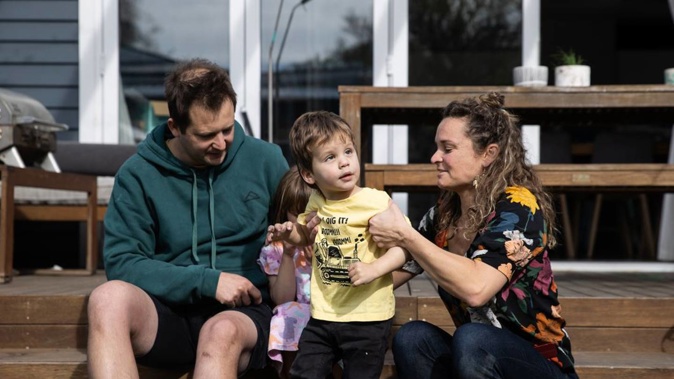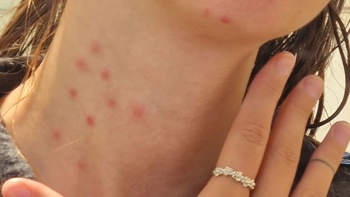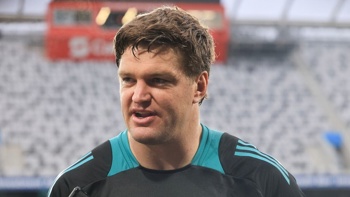
A Christchurch toddler suffering from a “one-in-a-million” genetic blindness condition has been given a rare window of opportunity to receive treatment.
Ciro Carrascull suffers from Leber congenital amaurosis (LCA), a rare inherited retinal degeneration that affects the photoreceptors behind his eye and causes low vision.
If the condition goes untreated, the 2-year-old is expected to be totally blind by the age of 5.
When the condition was first diagnosed in August last year, his mother Clara Pichon-Riviere was told by an eye specialist little was known about treatment options.
However, the specialist had exciting news in July after attending a conference in the United States - an experimental treatment had been discovered.
“This feels like a strange window of opportunity,” Pichon-Riviere told the Herald.
Ciro's condition was first diagnosed in August last year and there was little known at the time about treatment options. Photo / George Heard
“There was nothing available in New Zealand and suddenly there’s this opportunity that doesn’t have a lot of history, being so new, but I don’t know if we’ll get this chance again.”
Alarm bells were initially raised around Ciro’s health in November 2021 when, at 3 months old, he was taken into a 24-hour clinic with a cold before doctors noticed his constant eye movements.
They showed concern about his eyes and performed a number of CT scans, which revealed anomalies with a particular gene that affected his eyesight.
“It was good-bad news because we knew there was nothing wrong with the brain or anything else, but his vision was low,” his mother said.
In April this year, Ciro was taken to the University of Auckland to meet with associate professor in ophthalmology Andrea Vincent to determine possible treatments for his eyesight.
Initially, Vincent couldn’t provide answers about a cure. She attended an eye genetics conference in the United States a few months later and, in July, was eager to share what she’d discovered.
“She was very excited because she’d learned of these great developments on what Ciro has, but she needed to do some scans on his retina,” said Pichon-Riviere.
Ciro’s illness means the photoreceptors in the back of his eye don’t produce the correct amount of proteins and, as a result, the retinas don’t develop as normal.
Eventually, they’re expected to weaken and stop working altogether.
Ciro's condition affects the photoreceptors in the back of his eye - the correct amount of proteins isn't produced and the retina weakens. Photo / George Heard
The condition is known to occur more commonly in teenagers, so research and treatment have been designed for that age group and involves assisting their DNA.
Pichon-Riviere said she was told by the specialist of a treatment performed in only four other children worldwide - now her son would be given a chance to receive the same treatment in the UK.
The surgery, called gene therapy, has only been performed on people in Ciro’s situation since 2019. It’s a surgical process of introducing new DNA into the patient’s photoreceptors and pushing the DNA code to produce stronger protein.
The treatment, costing more than $1 million, is fully funded by the UK government under a hospital exemption - and Pichon-Riviere has the chance to take her son overseas to receive the surgery.
“But there’s a lot of theoretical risks,” Pichon-Riviere said.
The lack of tried and tested aspects of the treatment meant there were question marks around how safe it was and there was a possibility the surgery wouldn’t be made mainstream due to its cost.
“On one hand, it feels like if they do find more children then they’ll run out of what they came up with, on the other hand, Ciro will most likely be blind by 4 or 5, so he won’t have another opportunity. So we’re in the spotlight.”
Pichon-Riviere has begun fundraising online to make the trip to the UK possible - the money would cover her time off work and the living costs associated with the minimum two months spent overseas.
Gene therapy is fully funded by the UK government under a hospital exemption. Ciro's family has been given the chance to take their son overseas to complete the treatment. Photo / George Heard
If anything went wrong during the operation there was a chance the trip could be lengthened to six months, Pichon-Riviere said.
“We’ll need to be able to raise the money, otherwise I don’t think we’ll be able to afford to go.”
Ciro’s low vision has become an opportunity for him to express the humorous side of his personality, Pichon-Riviere said. Her son has learned to make jokes and laugh about his condition when times get hard.
“He’s very clever - he knows how to not feel like he’s missing out,” she said.
“But he does bump his head quite a lot, if we go to a new place it takes longer for him to adjust and know where he is. Sometimes he feels scared of exploring but he’ll hold your hand for support, he wants to go out as much as he can.”
Pichon-Riviere said she and her husband have learned how to communicate with their son - it’s taken adjustment and “can be a bit draining” - but they’re proud of the work they’ve done to create a safe environment for him to grow up in.
“We do feel the reward of him achieving certain things,” said Pichon-Riviere.
“You can tell he will just do things differently. We’re very patient and describe everything for him, the hard work all pays off in the end.”
‘The only child in New Zealand with this condition’
Vincent spoke to the Herald about Ciro’s unique condition, which she said sets him apart from every other child in New Zealand.
“We have a database of 1500 people that we do gene testing on and he’s the only one [with LCA],” said Vincent.
She said the condition comes from a rare recessive gene carried by both Ciro’s parents.
“One copy of the gene is normal but the other isn’t - so it’s like your car running on half a tank of petrol. And through an extremely cosmic coincidence, the father also carries the same mistake but the other copy is fine,” said Vincent.
“There was a one-in-four chance of Ciro inheriting the mistake and, boom, his car runs out of petrol.”
She said the preclinical studies of this experimental treatment shown to her in the US showed huge promise, but the possibility of Ciro benefitting from it rode on whether he had enough functioning cells in his retina.
Subsequent tests found Ciro had what was required for the surgery to work - now it was about getting the family to the UK to make use of the rare procedure.
“They only have 11 vials of this stuff left, they produced it at cost - it’s so expensive to make.”
It’s hoped the surgery’s outcome would be, according to Vincent, enough to change Ciro’s life for the better.
“It means their visual functioning and mobility improves because their fields have improved, their contrast sensitivity and quality of life is massively improved.”
Take your Radio, Podcasts and Music with you

/cloudfront-ap-southeast-2.images.arcpublishing.com/nzme/GQ7TD5RUZNGOJNIWRW47APEQOE.JPG)
/cloudfront-ap-southeast-2.images.arcpublishing.com/nzme/FX4IGB7WWRGFFCTP52XHXLVLI4.JPG)
/cloudfront-ap-southeast-2.images.arcpublishing.com/nzme/NUJRGCQJMZAQDCWQW7ATWKUH6I.JPG)








